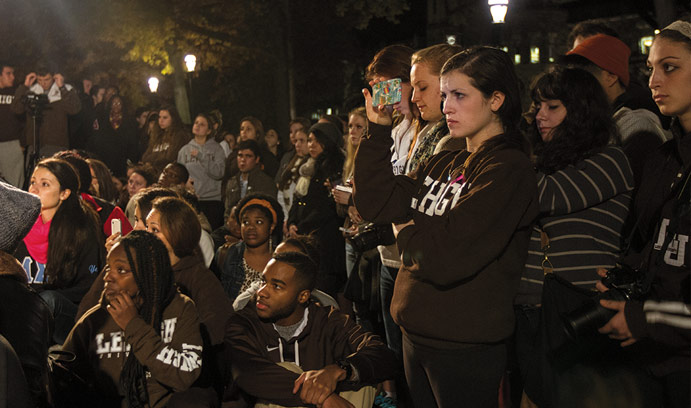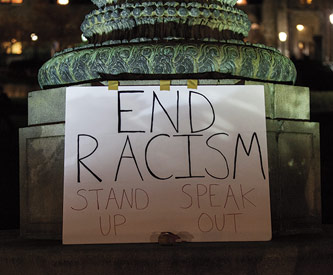A Call to Action

Early in the fall 2013 semester, a group of undergraduate students came together to lead the campus community in taking a proactive stand against inequality and discrimination.
They called themselves FBR—short for “From Beneath the Rug”—and expressed their view that Lehigh needed to open up the dialogue about diversity issues on campus.
In October, the students posted fliers in buildings across campus that touched on a wide range of topics related to discrimination. They staged a silent protest on October 4, held open forums to engage the community in dialogue, and worked with university leadership on several objectives. At Founder’s Day on October 10, student speaker Brenda Martinez ’15 challenged the university community to take a more proactive stand against discrimination. She called attention to the protests and the fliers, and she read anonymous statements from current undergraduates, which described instances where students felt targeted or marginalized as a result of their identity.
Sadly, an incident of hate and racial intolerance followed only weeks after Martinez’s speech. In the early morning hours of November 6, the UMOJA House—a residence hall established in 1989 as a safe space for underrepresented students of color—was egged, and racial slurs were spray-painted on the exterior of the building and on sidewalks and staircases near UMOJA and McClintic-Marshall House (M&M). The vandalism came at a time when UMOJA was celebrating its tenth year on ‘The Hill’; it moved there from Warren Square in 2003.
After the incident--—one which President Alice P. Gast swiftly condemned as “cowardly and hateful”-—Lehigh came together to demonstrate unity and condemn intolerance. “The provost and I are strongly supportive of, and will continue to be involved with, the student groups that have come together to make Lehigh a welcoming place of mutual respect,” Gast said in a message to the entire campus community. “We all need to stand together as a community against all acts that are motivated by intolerance and aggression.”
Horrified by the photos of the vandalism that circulated on social media, several professors and their students gathered for an impromptu discussion in the Maginnes Hall lobby the day of the incident. The discussion continued in Grace Lounge in the University Center. Later that evening, more than 1,600 students, faculty and staff assembled on the University Front Lawn for a rally organized by FBR and others, where community members spoke out and shared their experiences at Lehigh with respect to issues of equity and inclusion. The rally was followed by a march to the UMOJA House.
“The impetus for the rally was generated by students, with support from the faculty and help from the administration,” said Provost Pat Farrell. “It was a student idea to have such a rally, and I really consider that very impressive-—not only how the rally originated, but also that so many on campus were willing to come out and support the overall notion that we can and should take responsibility for improving the climate on campus.”
“My initial thought at the rally was ‘Wow, the students are not here alone. There are people who are paying attention,’” says Tyrone Russell, director of multicultural affairs. “But more so, it made me feel that you shouldn’t let the act of two or three people make you feel as if the whole world is against you.”
While the rally was an important moment for the campus community, James Peterson, director of Africana studies and associate professor of English, says that it should not be considered an end point in Lehigh’s effort to create a more inclusive environment for all students. Peterson believes that it is easier for the community to embrace FBR’s mission in the aftermath of what happened at the UMOJA House incident, because the students were proactive in jumpstarting conversations on some challenging topics.
“FBR is the model on leadership on equity for us. It’s collaborative, it’s proactive and I think it’ll be sustainable,” says Peterson. “These are the same kinds of students that were involved in The Movement. It was a different time, but it’s the same kind of student.”
Conversations about social hierarchies and privilege, Peterson says, are part of the reason why FBR’s efforts early in the fall semester were met with some resistance. Others agree, but they say that such conversations, while not always comfortable, can be invaluable. “[Conversations about privilege] are uncomfortable, they can be messy, and people’s feelings are going to be hurt for a while,” said Rita Jones, director of the Women’s Center and a faculty member in women, gender and sexuality studies. “Let’s be okay with being uncomfortable.”
To that end, university leadership, including President Gast and Provost Farrell, have regularly met with students to develop a list of action items to work toward making Lehigh more inclusive. They plan to establish a permanent student group that will work on projects that will positively affect the campus climate. Diversity and inclusion will be the major topic for the February 2014 Board of Trustees meeting.
“What’s happening now, and what will continue happening in the coming weeks and months, is figuring out how we coordinate our efforts to avoid duplication,” says Henry Odi, vice provost for academic diversity. “If we’re not coordinated, there will be duplication of efforts, there will be people working in silos, and there will be an increase in frustrations. Working alone is not going to help us grow.”
“We need to move ahead on the ideas that will make the biggest difference now, and develop a thoughtful, comprehensive plan going forward that incorporates the best of our ideas,” says John Smeaton, vice provost for student affairs. “Short-term and long-term initiatives that change the culture are essential.”
Lehigh will assess the need for a curricular requirement related to diversity and inclusion. Odi says that while there is a strong offering of such courses currently offered, the university must also expand those courses and recruit more diverse faculty. He is currently leading an effort alongside department chairs and faculty to facilitate the development of inclusion action plans for each academic department.
Russell, who works closely with students, said it was important to avoid underestimating Lehigh’s ability to address its issues and transform the culture.
“Why are we in the business of education if we can’t take on this challenge?” asks Russell. “We bring an 17- or 18-year old to campus, with professors who are masters of information; why do we do that? It’s because we know the capacity for learning is unlimited.”
The university is working to create a curriculum for incoming first-year students prior to their matriculation. This summer opportunity will be geared toward first-generation college students and other identified student populations in order to support their successful transition to Lehigh. The UMOJA House is an important component of Lehigh’s effort as well–leadership is working closely with students to develop more programming in the space and is considering potential facility improvements as well. “The UMOJA House should be a shining beacon in terms of residential life that reflects our commitment to the celebration of diversity and culture,” says Peterson.
While university leadership acknowledges the fact that changes must continue, they also recognize the fact that Lehigh’s progress on these issues over the years has empowered students to speak out and challenge the community to improve. The advocacy and equity unit of student affairs–the Office of Multicultural Affairs, the Women’s Center, and LGBTQIA services–and several academic departments have helped students find their voice.
“What we’ve done in this office and in other offices is this: we put students in positions to be confident and comfortable at this institution and still feel supported, which is why they aren’t transferring out,” says Russell.
“The emergence of the FBR group has been a gift to Lehigh,” says Smeaton. “Their passion, courage to speak out, and their focus on unity and constructive conversation centered on improving Lehigh has been amazing.
Adds Farrell: “I think the most important thing is that we’re now viewing this issue be a constant topic of conversation. I think, in the past, it’s been almost episodic—maybe giving the illusion that the issue was raised, the issue was addressed and the problem was solved. We now recognize that it’s not episodic, and it will take sustained, consistent effort o to make the kind of progress we’d like to make.”
Posted on:


